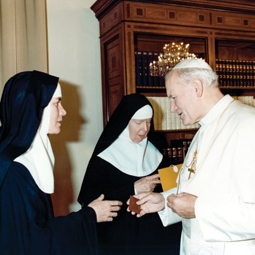 A week ago I spent a few hours with a friend, Melkite priest Father Romanus, at the Monastery of Our Lady of Beatitude in Livingston Manor, New York. Quiet and sanctity are felt immediately on the long drive up the road approaching the monastery. I had last been there in 2010 and I posted a piece here on Communio about my visit.
A week ago I spent a few hours with a friend, Melkite priest Father Romanus, at the Monastery of Our Lady of Beatitude in Livingston Manor, New York. Quiet and sanctity are felt immediately on the long drive up the road approaching the monastery. I had last been there in 2010 and I posted a piece here on Communio about my visit.
The purpose of our visit was three-fold: to spend time catching up; to introduce Father Romanus to the monastery and then to visit the gift shop. The latter point of our visit allowed us to purpose some beautiful religious items not easily found in other places.
This monastery is located in the Archdiocese of New York having been invited to settle there by the late John Joseph Cardinal O’Connor. The monastery of nuns is part of a larger group of monastics who form the Family of Bethlehem, of the Assumption of the Virgin and of Saint Bruno. According to 2007 statistics, worldwide there are approximately 650 monks and nuns in 33 monasteries of nuns and 4 monasteries of monks.
Today, is the anniversary of Monastic Family’s founding in 1950. Their history dates their foundation to when the Pope Pius XII defined as dogma, the mystery of Mary’s Assumption. Some of founders where present in Saint Peter’s Square.
As the monks and nuns speak of their vocation, we learn, as a total self-gift “to share the life of the Mother of God, present in the Trinity, in a life of adoration of the Father in Spirit and Truth.” Continual adoration of the Lord is their gift. Consequently, what was born first were the monastic nuns in 1951 living “the Project of the Virgin” in silence.
In the previous blog post I noted that these expression of monastic life does not fall into the usual way of thinking about a life of seclusion in the West. The Monastic Family of Bethlehem have a few defining characteristics: first, the biblical typology and the study of the Church Fathers and Mothers of this form of monastic life is striking, more so than what one may experience with the Benedictines or Cistercians –the use of sacred Scripture with this religious group, for me, is very profound; second, there is a distinct Eastern feel to the experience in that the Monastic Family has adopted an adapted 4th century interpretation of lauras found in the East in which they connect with what the German Saint Bruno did in the 11th century. A hermits life with some communal activities during the week aside from certain prayer periods like Lauds, Vespers and Mass.
As an outsider to Our Lady of Beatitude my perspective is that the life lived by these nuns is truly otherworldly: a sincere and serious commitment to silence, work, study, solitude, and prayer. We were present to sing Vespers —a unique experience—if you’ve never prayed according to an adapted Byzantine usage. The nuns made some very reasonable changes in what would be considered “normal” Byzantine Vespers in the way they sing the psalmody, make the intentions, the proclamation of the daily gospel and a few other things.
There are hermitages for personal retreats of the laity available.
Contact: 393 Our Lady of Lourdes Camp Road, Livingston Manor, NY 12758 USA
Tel: 845-439-4300

 You know from a previous post here that
You know from a previous post here that 